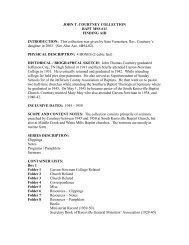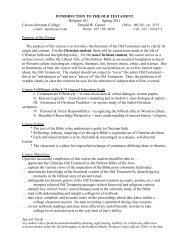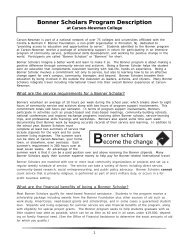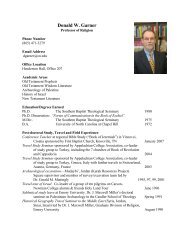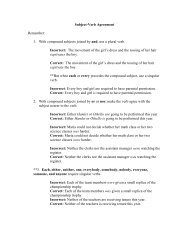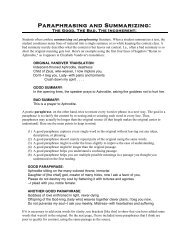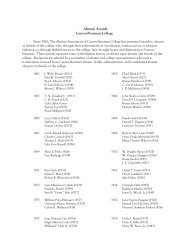a comparative analysis of louis durey and francis poulenc's settings ...
a comparative analysis of louis durey and francis poulenc's settings ...
a comparative analysis of louis durey and francis poulenc's settings ...
Create successful ePaper yourself
Turn your PDF publications into a flip-book with our unique Google optimized e-Paper software.
34<br />
Le Chèvre du Thibet—Poulenc<br />
Poulenc also opted for a minor tonality in his setting <strong>of</strong> “Le Chèvre du Thibet.”<br />
As the vocal line <strong>and</strong> accompaniment enter on the pick up note, the G minor tonality is<br />
immediately established. The accompaniment, carrying mainly eighth-note values, is to<br />
be played evenly, as is the vocal line. The bass line has a walking-bass sequence that<br />
plods along in measures 2, 3, 6, <strong>and</strong> 7.<br />
For the most part the vocal line oscillates between two notes. The largest interval<br />
in “Le Chevre” is a major third. There are few dotted rhythms—predominantly, straight<br />
rhythms are sung. The accompaniment is simple, yet effective: measures 2, 3, 6 <strong>and</strong> 7 <strong>and</strong><br />
identical, as are measures 4 <strong>and</strong> 5. The first two lines set up a comparison for the last two<br />
lines: the golden coat <strong>of</strong> the goat that Jason pursued is nothing compared to the hair <strong>of</strong> the<br />
poet’s lover.<br />
Fig. 2 “Le Chèvre du Thibet,” mm. 4-5<br />
The climatic part <strong>of</strong> this poem is introduced in the sforz<strong>and</strong>o placed over the word<br />
“Jason” in measure four. It is interesting that “Jason” is emphasized in this way. It is<br />
puzzling to consider why Poulenc would make an allusion in the poem the loudest word<br />
in the song. Durey chose to emphasize the last line—about the poet’s lover—instead. As



